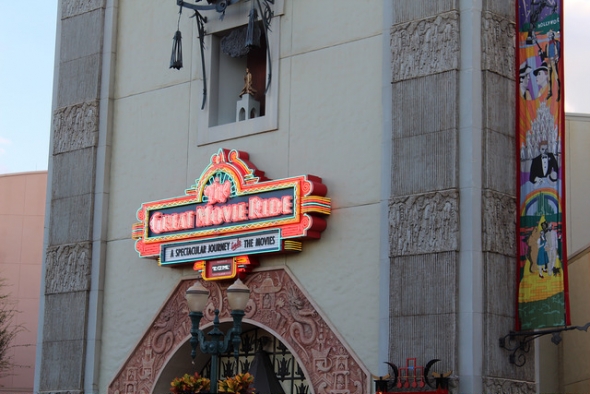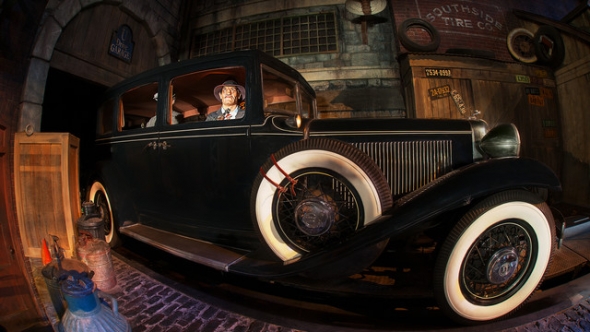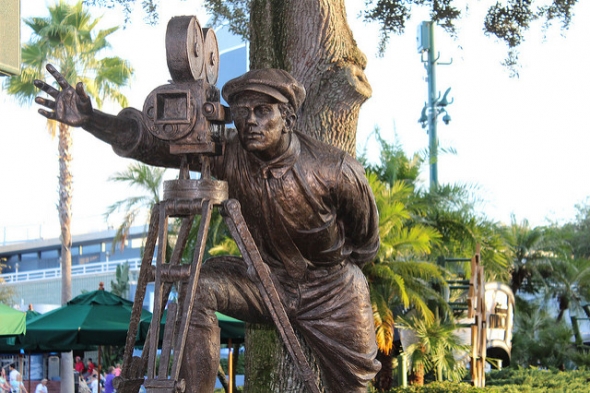The Great Movie Ride(s)
Once Disney officials verified the mere possibility of a new theme park within 10 miles of Walt Disney World, they proactively moved to step on the neck of the competition. They already had the plan in place, too. Better yet, the ideas driving the third gate were the stuff of Disney royalty. No, I’m not referencing any princesses but instead then-CEO Michael Eisner and future Disney Legend Marty Sklar.
During the lead-up to EPCOT Center, Sklar and another Imagineer, Randy Bright, pitched several ideas of pavilions. One of them stood out from the rest. It was entitled, “Great Moments at the Movies.” You know it today as The Great Movie Ride. This “pavilion” would have created a direct connection between EPCOT Center and Disney’s storied movie history. It also would have celebrated the other classic tales of the golden age of cinema. The only problem with the pitch was that it was too good.
Eisner and Sklar quickly agreed that Great Moments at the Movies would feel like a cheat as a pavilion. Instead, it was a concept worthy of an entirely new theme park. That was the plan that wound up in mothballs before Universal Studios unintentionally started a new theme park arms race when they acquired land in Central Florida. At that point, Disney officials decided that they already had a premise that was construction-ready. All they needed to do was flesh out a few more ideas, and they could break ground on a third park.
Fate was in their corner at the start of the new venture. In 1985, Disney entered into a new agreement with Metro-Goldwyn-Mayer Studios (MGM) that gave the Mouse House the rights to the MGM name. Disney could use the historic, world-famous MGM name and Leo the Lion logo for their new theme park. It was a savvy acquisition that opened up the celebrated body of the MGM library.
Disney so loved the idea that they planned to do it twice. They would open a second gate at Disneyland around the same time as the third gate at Walt Disney World. This location would sit in Burbank, roughly 35 miles away from Disneyland. The announced name was Disney-MGM Studio Backlot, and it was a clever shot across the bow of Universal Studios. As they attempted to attack Disney in Florida, the Mouse House would target them in the greater Los Angeles area. Theme park tourists on both coasts could enjoy Great Movie Rides.
I hate when mom and dad fight
Image: Disney
Divorces are always hardest on the children. In the case of The Walt Disney Company, their marriage with MGM barely lasted long enough to enjoy the honeymoon. After culminated the relationship in 1985, MGM quickly met somebody else: Ted Turner.
The man colloquially known as The Mouth of the South had a single purpose in the MGM purchase. He coveted the movie catalogue that would fittingly become the cornerstone of Turner Classic Movies, whose presence has been integral to the existence of The Great Movie Ride since its inception. Turner purchased the company, acquiring tremendous debt in the process. In order to negate some of his debt, Turner flipped many of the assets from his MGM acquisition quickly. Within months of his becoming owner of the fabled corporation, he’d stripped it for parts.
Once and future MGM owner Kirk Kerkorian purchased some of those pieces from his former boss quickly. From them, he rebuilt an entertainment division known as MGM/UA Entertainment. It was one of those loathsome 1980s corporate deals that impacted the lives of thousands of employees while a few multi-millionaires found new avenues to billionaire status. What nobody at Disney could have anticipated is how much that transaction would impact their planned third gate.
Light on capital and seeing shadows everywhere, the new corporate overlords on the board of MGM/UA Entertainment loathed the Disney deal. It heavily capitalized on their brand without offering much tangible benefit in return. Disney’s licensing contract wasn’t satisfactory in their estimation. They sought legal excuses to break the deal. In reality, they were perfectly willing to extend the contract as long as Disney paid them more money. Understandably, Uncle Walt’s team wasn’t interested in doing so. From their perspective, they’d signed a legally binding document that was mutually advantageous to both parties. In their estimation, Disney-MGM Studios and its California twin would anoint MGM as the carrier of the torch of classic Hollywood cinema.
At the time, MGM/UA was all about the Benjamins, though. They discovered ambiguous language in their contract that allowed them to sue Disney. The point of conflict was, humorously enough, the unfunny Ernest Goes To… movies.
From the very beginning, Disney intended their third gate to double as a functional movie and television studio. They would film productions there while allowing park guests to watch the process unfold. Sometimes, the proverbial live studio audience mentioned as legal jargon during the credits for sitcoms would be people visiting Disney-MGM Studios for the day. For their part, MGM had a problem with it. That wasn’t the breaking point, though.
Ernest Goes to Divorce Court
The backlots at Disney’s new third gate at Walt Disney World were ready well before the park itself opened to guests. Rather than waste unused space, Disney embraced the filmmaking process by scheduling productions at their new Florida studio. One of the most heralded ones at the time was – I’m not joking – Ernest Saves Christmas.
In 1987, comedian Jim Varney capitalized on the surging popularity of his too-stupid-to-live but well-intended character, Ernest. The first outing, Ernest Goes to Camp, was a box office hit that earned a factor of seven more than its modest $3 million. One of the things Disney loved about the Florida studio lots is how well they could control the costs of their Touchstone Pictures productions. Even as Varney’s salary escalated due to delivering a critically praised box office hit (again, I swear this is all true), Ernest Saves Christmas cost Disney only $6 million to produce. It was another hit, grossing approximately $28 million.
This financial gain was a Pyrrhic victory for Disney. The attorneys at MGM attacked the language of their signed contract with Disney. They maintained that their business partner didn’t have the right to produce movies at the new theme park. An MGM spokesman argued, “"We thought we were licensing it to an attraction, a mock studio.” Effectively, MGM sued Disney for $100 million in 1989 because they signed a partnership agreement that meant Disney-MGM Studios was supposed to be fake, not real. From their perspective, they wouldn’t willingly enable a competitor in the film industry to create movies at a joint site without compensation.
Disney execs felt that the claims were laughable. They believed that they’d been forthcoming about their intentions from the beginning. Instead, they considered MGM’s lawsuit as a money grab from a cash-poor corporation. More important, Disney was salty about the attempt to break the contract. They fought back in vicious manner.





Comments
LOVE HOLLYWOOD STUDIOS! Three of the best rides at Disney are at HS... Tower of Terror, Rock-n- Rollercoaster, and Toy Story, Mania. Would have included Star Tours but it's so short. The other Star Wars attractions are great too. My family has always loved HS it's the highlight of our trips to Disney.
another great article! this site is amazing!
having recently visited both hollywood studios & WWoHP, it is easy to see how disney influenced universal in development as WWoHP really stands out as a full-concept and exceptionally detailed area compared to the rest of universal (which is more of a traditional amusement park). I hope that disney's new star wars and the other lands help flesh out hollywood studios as it is lacking and disjointed compared to their other parks.